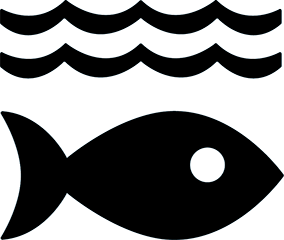Third Place - High School
UN Sustainable Development Goals Addressed
-

Goal 14: Life Below Water
2022 Youth Design Challenge
This design concept was developed by participants in the Institute’s Youth Design Challenge. The descriptions below are from the team’s competition entry materials.
School: Northview High School
Location: Johns Creek, Georgia, USA
Coach: Camillie Janess
Team members: Aadya Menon, Gauri Shetty, Karthik Mahakala, Sruthi Vangavolu
Video Pitch

Innovation Details
The local stormwater runoff issue in Johns Creek, Georgia inspired the Aquanauts to come up with the River Reef project as a way to mitigate the problem in their community. Stormwater runoff erodes the riverbanks, causing natural plants/trees to slowly submerge; and it drags sediment along its path causing several issues. The River Reef is a cluster of banana leaf-like structures with a rough surface made of RPET, a bio-friendly plastic, that can be adjusted and placed at the bottom of any waterway. The design uses strategies inspired by seagrass and rough cactus coral to help slow down currents and trap sediments carried by the water.
What is the problem your team solved for this challenge? What is the problem addressed? How is the problem connected to the selected SDG?
We solved the issue of stormwater runoff since it’s a very significant issue in Johns Creek. As this increases, the sides of streams erode, causing plants beside it to submerge, slowly destroying plant life along with it. Fast-flowing runoff then erodes banks by picking up sediments along its path. When left unchecked, stormwater can lead to polluted water systems and flooding. This problem is directly connected to SDG 14: life below water. This runoff eventually makes its way towards rivers/oceans, and that sediment that doesn’t get filtered out pollutes the water, causing damage and endangerment to habitats of species.
How was your solution inspired by nature? What (at least two) organisms did you learn from? How effectively did you combine the biological strategies for the final design?
We used seagrass, rough cactus coral, and banana leaves as our biomimicry aspects. Seagrass can trap sediment in the ground, decrease wave energy, and also protect coral life. The Rough Cactus Coral can buffer coastal lines against erosion because tall and rough coral can break wave energy. The shape of banana leaves is wide but thin, allowing them to stand up straight but flow against the water. We were able to effectively combine these three biological strategies for our final design to tackle 3 problems. Being able to decrease wave energy, removing sediment from the water flow, and protecting biodiversity.
What does your design solution do? How does it solve or mitigate the problem you selected? How did what you learn inform your design?
Our product is structured so that each strand is made using the banana leaf shape, the roughness of coral, and it is set together in nets, placed at the bottom of streams using stakes. The material used is called RPET, which is an eco-friendly, strong, and lightweight plastic. The wave energy decreases as it hits our invention because of the structure and movement of the RPET. The wide and thin shape of our product helps it stand up straight and push against the water. Our solution ultimately reduces wave energy, traps sediment, and prevents erosion in the long run.
